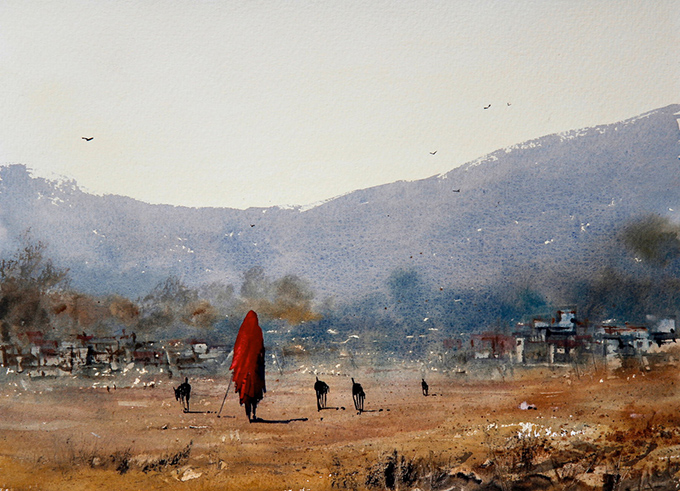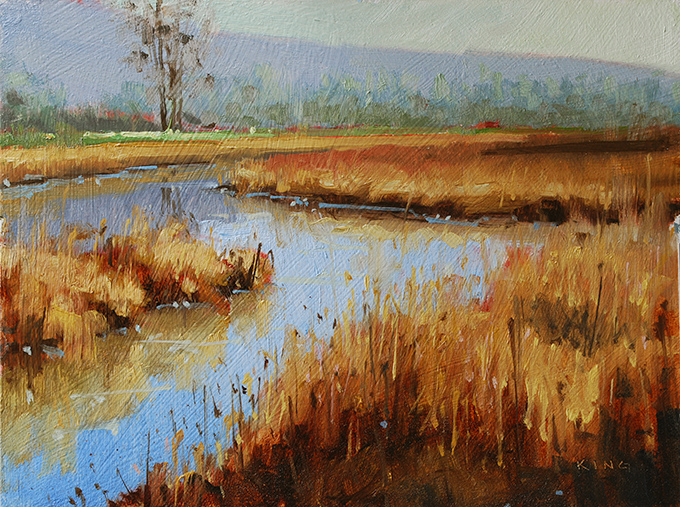Fresh Takes on Landscapes
May 9, 2019Take a trip with watercolourists Leslie Redhead and Sandhu Singh, and oil painters Michael King and Ken Faulks! With their fresh takes on traditional mediums and a love of landscape, they share ways to break free and find your own approach to expressing the beauty of the outdoors.
Jump to: Leslie Redhead • Sandhu Singh • Michael King • Ken Faulks
Leslie Lambert Redhead
leslieredheadart.com | @lredheadart
“I use pouring as a way to cover the paper quickly and to let the glow of colour come through the whole piece.”
How did you get into landscapes and how did pouring watercolours find its way into your work?
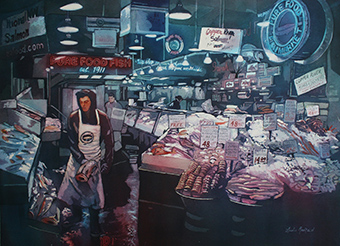
When I first started painting, I worked with mostly portraits and figures; I then realized I wanted to place my figures in their surrounding environment and to explore how to paint landscapes. I learned how to paint the landscape as it was but wanted to be able to better express the feeling and sentiment of a place. As I began experimenting more with colour and mood, I discovered that by pouring watercolour, I was able to capture more of what I felt and envisioned. What I didn’t realize when I started is I would also come to love the way it moves.
When I discovered that I could pour liquid watercolour, I found that it flows and dances across the paper as it interacts and mingles with other colours. It opened a new way of painting for me. I now pour in most of my paintings, either from beginning to end or as a base layer before putting in brush work, allowing for a spontaneity that differs from just a wash of colour. The colour mixes are unique and can sometimes be a surprise. Recently, I have begun to explore painting even larger landscapes with watercolour, going as large as 9 feet on one side in a recent piece. I use pouring as a way to cover the paper quickly and to let the glow of colour come through the whole piece.
What do you use as your source material? Do you work en plein air, from sketches, or from photographs?
My source material is mostly a photograph or a combination of photographs. I often use Photoshop as my sketchbook, cutting and pasting from various photographs that I have taken when I travel or from just around home. Once I have figured out a composition that I like, I will then see if it works as a black and white image and make adjustments if necessary. For my larger paintings, I will then paint a small colour study before I move on to the bigger image.
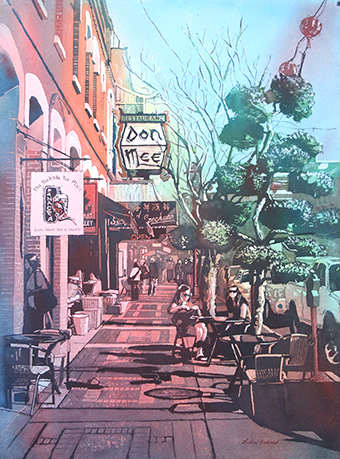
On average, how much of your final piece is a reflection of the reality of the landscape, and how much have you influenced it to change or enhance the composition?
The structure, or what I like to call the bones, of the place is based on reality. However, I do sometimes manipulate the composition by placing figures or objects that will improve the setting and lead the viewer’s eye around the piece. Additionally, I will use value to enhance the composition and cause a certain part of the piece to have more of an effect. I will also embellish a painting with colour.
What do you find is the biggest challenge in painting a landscape?
The biggest challenge of painting a landscape is that of being able to capture an emotion or mood of a place that resonates not just with me but with its viewers as well. •
Get a glimpse into how Leslie Lambert Redhead works with poured watercolour in her video, 365 Seconds of Pouring Watercolor: The Fork That Ran Away With the Spoon.
Sandhu Singh
sandhusingh.com
“Sometimes crowds can be a challenge. They stand beside you and say, ‘I don’t see that.’ It doesn’t matter! You don’t need to see what I see, it’s my painting.”
How did you get in to painting landscapes?
When I started painting, I think it was just around that time that I went to Nova Scotia. There was this beautiful colorful barn and I fell in love with it. I like buildings and the tilted roof was especially exciting. Even today, a lot of my barns come from there. If I haven’t painted for a while, I’ll think of a simple landscape to get my hands rolling. It’s not my favorite, but I do it.
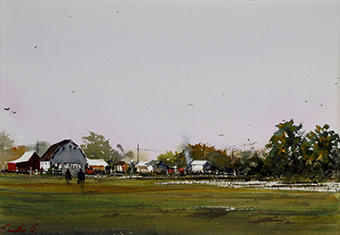
So, you find that the pure landscape is not really as exciting as when there’s buildings?
I think this is the most important piece here: it’s not the painting, it is the story within the painting that makes it exciting. If there’s no story, it’s just another piece, another photo, and it has no meaning to me.
There’s a one barn on up on the way to Duncan. It’s beautiful and my kid says “Daddy, why don’t you paint that?” Well, I’m going 90 clicks, I can’t stop to take a photo. I have driven that road for 10 years now, going up and down, imagining. When that piece comes into my painting, it comes from the heart and then there’s no worrying about the subject, it just comes easy.
What do you use as your source material? Do you work outdoors or from sketches.
I do all the things! I use photos and plein air, too, but I generally focus on my imagination because then I’m not competing with the subject matter. It then evolves into a bigger painting.
How much of a piece is a reflection of the reality of the landscape, and how much have you influenced it to change or enhance the composition?
If it’s a commissioned piece, I have to stick with what they want but, if I’m doing it for my own pleasure as most of my paintings tend to be, I tweak things a lot. I read somewhere. “I’m the director. I’m the principal. I’m the producer. It’s my painting.”
Once you start to paint what you see exactly, I think that can be a pitfall for many painters. Often people don’t realize that the faster you paint with watercolours, the better it is. A single brush stroke is a lot more powerful than twenty.
I do a lot of wet on wet, keeping things moving by paying full attention to what’s going on in different corners of the painting and not wasting too much time getting caught up in one spot. If that helps the viewer to go into the painting and it helps me to go into the painting, then there’s a depth, and there’s nothing wrong with it. I always believe what’s right and what’s wrong depends how you view it and, if you view it with compassion and love, no problem. If you’re self-critical, no matter how many workshops or classes people take, they’re never going to come out of it. That’s therapy material!
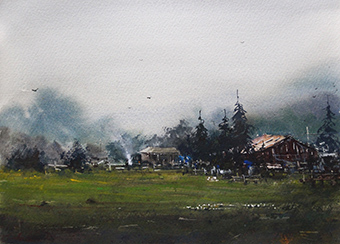
What do you think the main feature of your artwork or style is that sets you apart from other artists working in the same subject matter and medium?
It’s hard to compare but I often see people not using their tonal value and it can become really wishy washy – it looks that you’re not sure where you’re supposed to paint. Watercolors tend to dry lighter as time goes on so, when you start lighter, sometimes there’s not enough depth.
What do you find is the biggest challenge in painting a landscape?
Composition. What I call nature material, such as fields and all of that, that’s not a problem but if you put a barn in there, it has to look half decent to look like a barn. Otherwise it doesn’t jive with the rest of the stuff you get to put in there. In my painting, I put a lot of barns, people, shrubs, and whatnot. There is some free style painting brush strokes going on there, some of them are very concrete, but every painting you need all the different techniques to make it good. Especially me, I’m such abstract impressionist that everything is not concrete. So I go fast and, if the composition is not right, I think it will stick out.
That’s how I look at my early work, from eight years ago, nine years ago. I don’t often do workshops but I save the work to show the students that, “Look. It wasn’t easy but look, I came this far starting from there.” •
Michael King
michaelking.ca | @michaelking.ca
“I don’t give up, I just keep walking until I see something that stirs me to set up and paint.”
How did you get into landscapes? Why do you choose to paint landscapes?
I started painting plein air about 10 years ago now, so I defaulted into landscapes. At first I did it for the challenge, but after learning more about landscape painting, composition, value and colour control, that is when I started to love painting the beauty of randomness that is forced upon you when you decide to put down your pochade box on location.
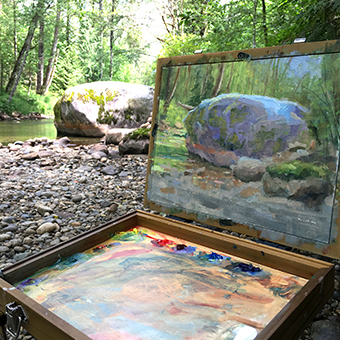
What do you use as your source material? Do you work en plein air, from sketches, or from photographs?
Painting from life is my muse, particularly plein air. Plein air has spoiled me for so many years that I have to be either painting outside, from a still life in front of me, from someone sitting for me or just from a mirror looking at myself. I find it tedious and boring to paint from photos as there is a lack of life due to the absence of shifting light. I’d rather clean a toilet than paint from photos. Why? It’s the change of light over time that I find breathes life into a scene or object. Specifically, how the light shifts and glints differently as time passes or when you move your head from side to side and see a beautiful shimmer. That is what makes painting exciting for me. I love that “all of a sudden” change in light that makes the scene or object become more than it is. When this shift of light gets added to your work, it shows. I have to clarify that I am not advocating one ‘chases the light’, that will kill you every time, but seeing and adding that one ‘damn, that’s nice!” shift of light, makes all the difference.
On average, how much of your final piece is a reflection of the reality of the landscape, and how much have you influenced it to change or enhance the composition?
Depending on the scene I am painting, the final piece can contain anywhere from 50-90% reality. There is so much I leave out, move around, or just change because I either don’t care or I feel I need to. I tend to leave out a lot of things (especially small details), push colour and value, and move anything that I find is not in the right spot.
What do you think is the main feature of your artwork or style that sets you apart from other artists working in the same subject matter and medium?
At this point in my journey, and this is the simplified statement, I would say the bold brushstrokes and the multitude of colours I use to create pieces with depth and luminosity.
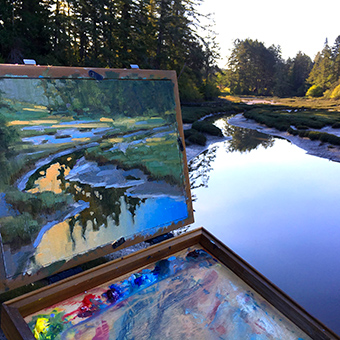
What do you find is the biggest challenge in painting a landscape?
Finding a great location to paint at the right time of day. I try to venture out and explore areas, always thinking about how the light will be in the early morning or late evening. So many locations are devoid of artistic life and interest during midday, but get the right light and excitement abounds. The reverse is also true, you think you have a great spot but when the light hits, nothing happens; no inspiration, no life. At that point, I don’t give up, I just keep walking until I see something that stirs me to set up and paint. •
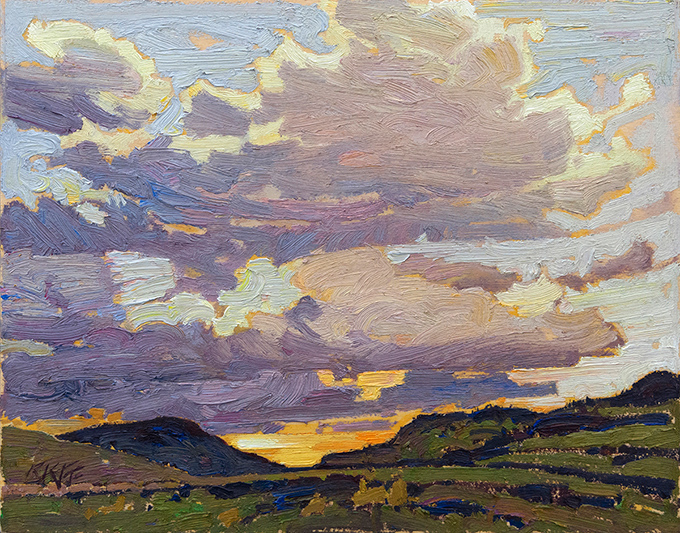
Ken Faulks
kenfaulks.com | @kenfaulksvisualartist
“I figure a painting style is kinda like handwriting: we’re all using the same 26 letters, yet each person’s handwriting is different and unique in style.”
How did you get into landscapes? Why do you choose to paint landscapes?
I initially started out as a freelance illustrator in ’84 and in ’88 I reconnected with a painter friend of mine who had just started plein-airing. I started going out as well and have been doing so ever since. The landscape is just ‘there’ and I’ve always found it interesting enough to stick with. It’s easily accessible, varied, and every bit as challenging as any other ‘from life’ subject. I’ve always been interested in painting other subjects and have done so – abstraction, the figure, and the portrait, for example – but one doesn’t have to hire a model to paint a landscape.
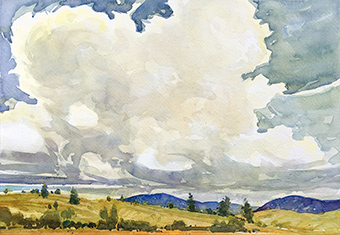
What do you use as your source material? Do you work en plein air, from sketches, or from photographs?
A lot of my work is plein air. I work in the studio as well, and plein air work is quite often used as reference for the larger studio paintings. At times I may work from photos I’ve taken.
On average, how much of your final piece is a reflection of the reality of the landscape, and how much have you influenced it to change or enhance the composition?
If it suits, I can sometimes be quite literal when constructing/composing a painting, but in the end, the painting has to work as a thing unto itself. So, pulling out the artistic license is a regular occurrence.

What do you think is the main feature of your artwork or style that sets you apart from other artists working in the same subject matter and medium?
I figure a painting style is kinda like handwriting: we’re all using the same 26 letters, yet each person’s handwriting is different and unique in style. One develops a mature style of handwriting through years of doing. One’s painting style is basically like that. I guess if one’s authentic in developing ‘self’, then maybe ‘self’ is what sets one apart from the next.
What do you find is the biggest challenge in painting a landscape?
Sometimes the weather. Sometimes just opening the paint box. •
Dip into the outdoors with Opus Videos featuring urban sketching, ink, watercolour, gouache, oils, and more!
The Opus Outdoor Painting Challenge (OPC) is a fun and FREE event that takes place at Opus locations throughout BC. Share a day creating outdoors with your creative community and wrap it up an exhibition of the day’s art and thousands in draw prizes from our generous sponsors. Click here to register for OPC today!

